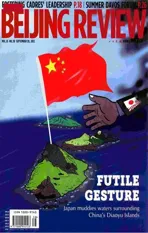IGNORING HISTORY,FUELING TENSIONS
2012-10-14ByGaoHong
By Gao Hong
IGNORING HISTORY,FUELING TENSIONS
By Gao Hong
Japan’s unilateral action breaks its tacit understanding w ith China

The author is deputy director of the Institute of Japanese Studies at the Chinese Academ y of Social Sciences
T he Japanese Government announced the “purchase” of China’s Diaoyu Island and its affiliated Nanxiao Island and Beixiao Island from the so-called “owner of Senkaku Islands”on September 10. Japan’s action drew attention to whether China and Japan have a tacit agreement on the Diaoyu Islands issue.
During negotiations before the two countries normalized diplomatic relations in 1972, the sovereignty of the Diaoyu Islands was a major obstacle. At that time, the normalization of relations was the priority in their diplomatic strategies, so then-Chinese Prem ier Zhou Enlai and Japanese Prime M inister Kakuei Tanaka agreed to discuss the issue in the future in order to prevent it from hindering the bilateral relationship.This could be regarded as the origin of China and Japan’s tacit agreement on the Diaoyu Islands.
In the second half of the 1970s, China and Japan were making efforts to adopt a treaty of peace and friendship. The agreement reached by late Chinese leader Deng Xiaoping w ith Japanese leaders on the Diaoyu Islands was well-known by the media and the public of the two countries. On October 25, 1978, Deng said during a meeting w ith Japanese Prime M inister Takeo Fukuda, “It is understandable that the two sides have different opinions on certain issues. For example, we have different opinions on the place that you call Senkaku Islands and we call Diaoyu Islands. It is a good choice that we do not talk about it in our negotiation. Our next generations w ill be w iser. We should take the overall situation as the priority.” Fukuda did not express disagreement.
However, after the UN Convention on the Law of the Sea took effect in 1996, the Japanese M inistry of Foreign Affairs suddenly changed its official stance of acknow ledging Japan’s tacit agreement w ith China, a move that triggered diplomatic protests from China.
The Chinese Government holds the position that China owns sovereignty over the Diaoyu Islands, while advocating the principle of “shelving disputes and going in for joint development.”
The Japanese Government also said the right w ing’s action runs counter to the government’s stance and the government would not participate in, support or accept it. Japan’s Coast Guard has consistently tried to prevent the right-w ing activists from landing on and transporting construction materials to the islands.
In 2002, the Japanese Government “rented” three islets in the Diaoyu Islands from Japanese individuals. Regarding this, China made strong representations to Japan. The Japanese Government said this action was aimed at “maintaining stable and steady management on the relevant islands and islets”and preventing anybody from landing on the islands.
Japan explained to China that this measure was designed to prevent Japanese rightw ing activists from landing on the islands to cause trouble. It continued to say that considering China would not accept the solution of the Japanese Government “nationalizing”the islands, it decided to “rent” them. Even recently, Japanese police still summoned and interrogated lawmakers who landed on the islands.
The facts above prove Japan clearly knows China and Japan have a dispute on the territorial sovereignty over the Diaoyu Islands. It can be seen that this dispute existed in the diplomatic practices of China and Japan in a tacit way for more than two decades after the two countries normalized diplomatic relations. After 1996, however, Japan began to deny the dispute, complicating the issue and setting a ticking time bomb for the dispute to explode.
The only solution is for China and Japan to negotiate calm ly and rationally for a new consensus. This solution w ill be conducive to the peace and well-being of the two nations as well as prosperity and stability in East Asia.
